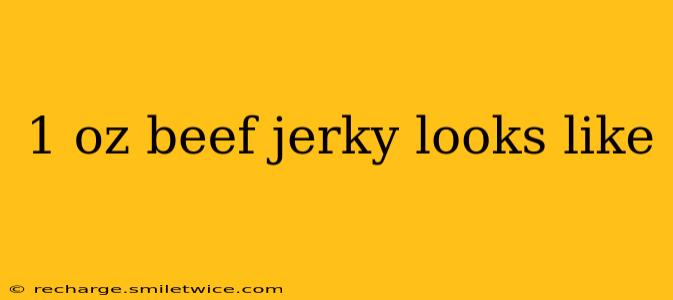What Does 1 Ounce of Beef Jerky Look Like? A Visual Guide and More
Beef jerky is a popular snack known for its savory flavor and chewy texture. But what does one ounce of it actually look like? It's harder to visualize than you might think, as the appearance can vary significantly depending on the cut of meat, the brand, and the preparation method. This guide will help you understand what to expect.
How Big is 1 Ounce of Beef Jerky?
There's no single definitive answer to this question. The size of a 1-ounce portion of beef jerky is highly variable. Think of it this way: a single, large piece of thick-cut jerky might weigh more than an ounce, while several smaller, thinner pieces could collectively make up an ounce. The type of cut significantly impacts the density and therefore the overall volume.
For example:
- Thick-cut jerky: A single piece of thick-cut jerky might be around 2-3 inches long, but it will be substantially thicker and weigh more than thinner cuts. One ounce would likely consist of one or two of these pieces.
- Thin-cut jerky: Thin-cut jerky offers more pieces per ounce. A 1-ounce serving might easily contain 5-10 or more smaller pieces, depending on their size and thickness.
- Steak strips vs. bite-sized pieces: The shape also affects perception. Long, steak-like strips will visually appear larger than small, bite-sized pieces, even if they weigh the same.
It's more helpful to focus on weight than on visual size. One ounce is roughly equivalent to 28 grams. Most jerky packages clearly label the weight, helping you gauge the portion size.
What Does the Color and Texture Look Like?
The color of beef jerky varies based on the type of beef, marinades, and smoking/drying processes used. Common colors include:
- Dark brown: Often associated with longer smoking or drying times, resulting in a richer, more intense flavor.
- Reddish-brown: This color is often achieved with shorter smoking/drying periods or lighter marinades.
- Slightly reddish: Might indicate a leaner cut of beef or a different processing method.
The texture is typically described as:
- Chewy: This is a characteristic feature of most beef jerky. The degree of chewiness can vary depending on the thickness of the cut and the processing method.
- Tough: Overly tough jerky may be a result of over-drying.
- Tender: Some types of jerky aim for a more tender texture, often achieved with specific cuts and processing techniques.
Different jerky manufacturers will have subtle variations in color and texture. This isn't a cause for alarm, and it adds to the diversity within this snack.
How Can I Estimate One Ounce of Beef Jerky Without a Scale?
Without a scale, visual estimation is challenging. The best approach is to familiarize yourself with the packaging of a brand you regularly consume. Once you understand the size of a 1-ounce package or serving, you can usually estimate reasonably well.
What if My Jerky Doesn't Look Like I Expected?
Variations in appearance are perfectly normal. Factors such as beef cut, brand, and processing will all influence the final product's size and appearance. Always check the weight to ensure you’re getting the correct amount.
By focusing on the weight and understanding the variations in color, texture, and piece size, you'll get a much clearer picture (pun intended!) of what one ounce of beef jerky looks like. Remember, it's the weight, not the visual size, that matters most.
